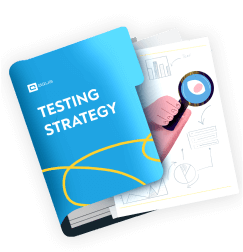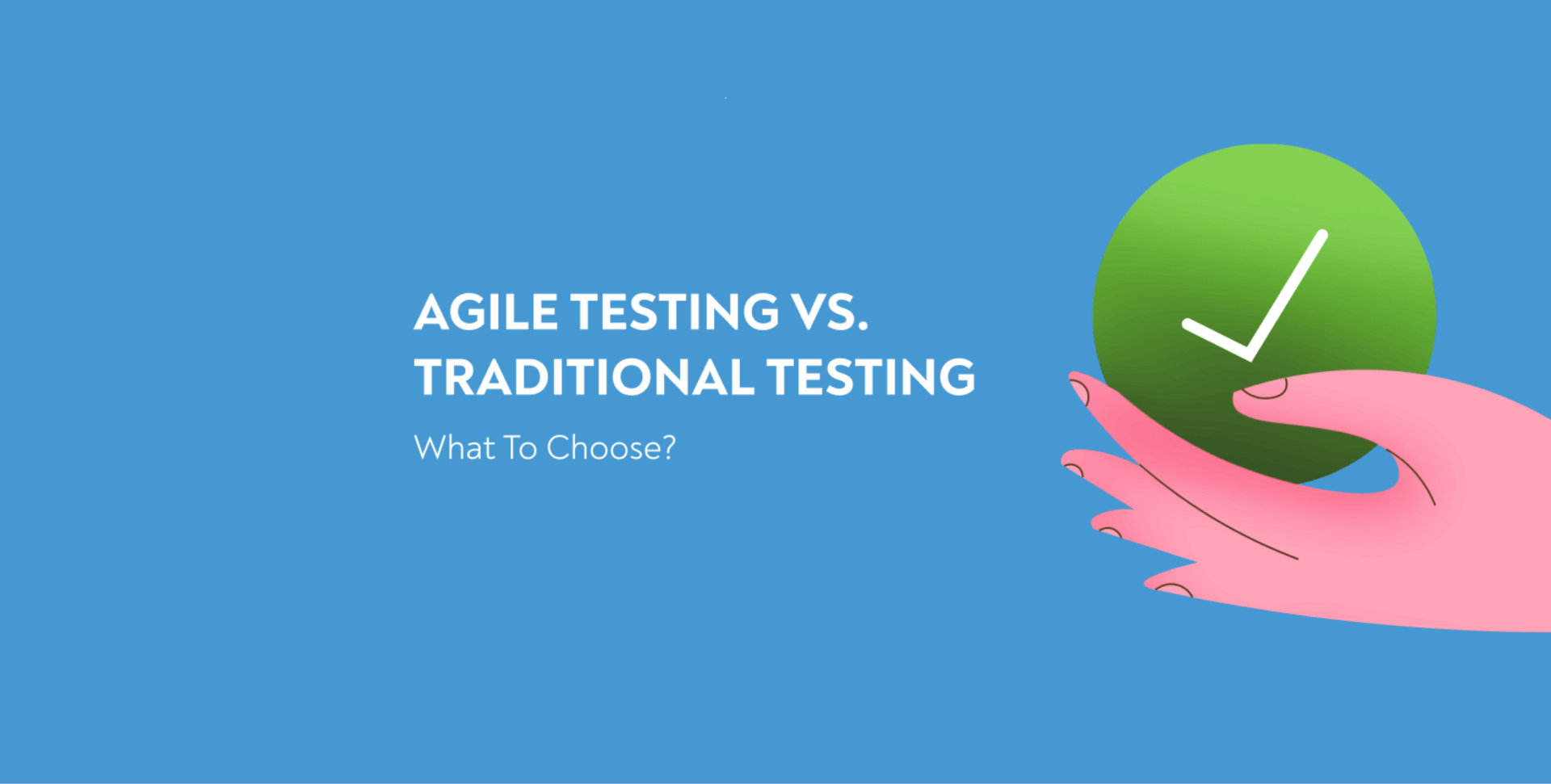Evolution is a process that changes everything in our world for the better and adapts to constantly changing conditions, including development and quality assurance. Evolution has not bypassed traditional testing as well. However, not everyone is always in a hurry to switch from traditional QA to contemporary approaches, for example, agile in software testing. Why not everyone is in a hurry to do this and what to choose we will analyse in this article. Let’s see what the differences between agile and traditional testing are.
Traditional testing definition
The traditional testing method is probably the most common quality assurance method. Its main difference from more modern methods lies in the incremental execution. Testers perform traditional tests from top to bottom. Having completed one phase, they move on to the next and so on until all defects are eliminated. It is released only after the software has been validated for bugs’ absence. This way of traditional testing can be described as the “step-by-step detection of bugs in ready-made software”.
- Not cost- and time-effective process as bugs are discovered and fixed at the late phase of development
- A lack of communication between software development and quality assurance departments affects the process's effectiveness
- Heavy reliance on documentation at the traditional approach leads to costs of writing and maintaining it
- Since the requirements are approved at the initial stage of development, it leads to the inability to modify them to meet changing business objectives

Get a testing strategy template that enables us to release 2 times faster
What is agile testing?
The agile testing method doesn’t isolate software development and testing from each other. Opposite to this, it encourages them to be executed simultaneously. The entire team is collaboratively finding bugs while validating the developing product. Only when both parts of the team agree that the result is satisfactory, they are ready to deploy it.
- Time- and cost-effective approach which gains to simplify and shorten the period of interactions for more efficient output
- Time- and cost-effective approach which gains to simplify and shorten the period of interactions for more efficient output
- It actually doesn't require the comprehensive documentation and requirements are adaptive
- It actually doesn't require the comprehensive documentation and requirements are adaptive
- Agile in testing provides rapid delivery and high-quality software due to collaboration with end-users
- Agile testing significantly reduces the time period from the start to the release to the market
- It also contributes to better risk management (reputational and financial) due to early discovery of defects and lower chance of a released product revoking
- It represents a very structured and thorough though very flexible approach for software development and testing all together
- Even though this approach doesn't require thorough documentation, its lacking causes problems in a case when the project grows or a new team joins to take over
- At the initial stage of development, it is challenging to determine the exact time, resources and efforts required by the project. It can cause a slight digression for the project budget
- Agile testing often demands requirements, workflow, defects and IT product testing management tools
Finding the all-in-one tool at a reasonable price and with an adequate number of licences might be complicated. However, aqua cloud is a pro in an agile testing approach and does its best to give you everything to start implementing modern methods.
Key differences between traditional & modern testing principles
These are the crucial factors that stand out when you put Agile vs traditional approaches:
- Timeline: Traditional software testing follows a linear, sequential approach, where testing comes at the end of development. Testers usually execute pre-defined test cases and verify if the software meets the specified requirements. Meanwhile, Agile testing adopts an iterative approach, integrating testing throughout development. Testers and developers collaborate closely and continuously provide feedback to each update. Agile testing focuses on delivering a working product in small increments, which is one of the advantages of Agile testing.
- Documentation: In traditional software testing, comprehensive documentation is a crucial aspect. Test plans, test cases, test scripts, and detailed test reports are common artefacts produced. This documentation ensures clear guidelines for testing activities and provides traceability. But Agile testing emphasises minimal documentation, focusing more on communication among team members. Agile teams rely on face-to-face interactions, daily stand-up meetings, and user stories to effectively capture and share testing requirements and progress.
- Feedback frequency: Agile testing places a strong emphasis on frequent feedback loops. Testing activities occur continuously throughout development, including rapid identification and defect resolution. Following a continuous improvement approach, Agile teams regularly receive feedback from stakeholders, customers, and end-users. Traditional testing, being more sequential, provides feedback primarily at the end of the development phase, which might lead to delayed bug detection and resolution.
- Team structure: Traditional testing often involves separate testing teams responsible for testing the software after development. In this case, testers are not deeply involved in the initial stages of development. In contrast, Agile testing promotes cross-functional teams that include testers from the beginning of the project. They collaborate closely with developers, product owners, and other stakeholders for better communication and shared ownership of quality.
- Project scope: Traditional testing generally suits well-defined projects with fixed requirements. Testing begins after the development is complete and the product is stable. Agile testing, on the other hand, thrives in dynamic and evolving project scopes. As Agile projects embrace change, the testing process continuously adapts to accommodate new requirements and evolving business needs.
Why is Agile Preferred Over Traditional Testing Approaches?
Agile testing is preferred over traditional testing approaches for several key reasons:
- Flexibility and Adaptability: Agile testing primarily focuses on adaptability and flexibility, allowing teams to respond quickly to changes in requirements or priorities. Traditional testing approaches often follow a rigid sequence of stages, which can make it difficult to adjust to evolving project needs.
- Continuous Feedback: Agile testing emphasises continuous feedback through frequent iterations and regular reviews. This approach ensures that defects are identified and addressed early in the development cycle, reducing the risk of major issues emerging later. In contrast, traditional testing often involves longer cycles, with feedback coming only after significant development has been completed.
- Early and Frequent Testing: In Agile, testing is integrated into the development process from the beginning, with tests being run continuously throughout each iteration or sprint. This leads to the early detection of issues and more reliable software. Traditional methods typically conduct testing in a separate, later phase, which can delay the discovery of critical defects.
- Collaboration and Communication: Agile promotes close collaboration between developers, testers, and stakeholders, facilitating better communication and alignment on project goals and requirements. This collaborative environment helps to ensure that testing efforts are more aligned with the actual needs of the project. Traditional testing approaches often involve more siloed roles, which can hinder effective communication and collaboration.
- Customer-Centric Approach: Agile testing focuses on delivering value to the customer by ensuring that the software meets their needs through iterative development and frequent releases. This customer-centric approach allows teams to gather and incorporate user feedback more regularly, leading to a product that better fits user expectations. Traditional testing methods may not involve customer feedback until later in the development cycle.
- Incremental Delivery: Agile testing supports incremental delivery, where software is developed and tested in small, manageable chunks. This incremental approach allows for more frequent releases and the ability to address issues and make improvements in smaller, iterative steps. Traditional approaches often involve larger, less frequent releases, which can result in longer feedback loops and more significant changes being required later on.
Overall, Agile testing’s emphasis on flexibility, continuous feedback, early and frequent testing, collaboration, and incremental delivery makes it a preferred approach in modern software development. It helps teams adapt to changes, deliver higher-quality software more efficiently, and better meet customer needs compared to traditional testing approaches.
| Aspect | Agile Testing | Traditional Testing |
|---|---|---|
| Approach | Iterative and incremental | Sequential and phase-based |
| Testing Frequency | Continuous testing throughout development | Testing typically done after development |
| Feedback Cycle | Frequent feedback with regular iterations | Feedback provided at later stages, often after significant development is complete |
| Adaptability | Highly adaptable to changes in requirements | Less adaptable; changes can be more costly and disruptive |
| Collaboration | Close collaboration between developers, testers, and stakeholders | More siloed roles; less frequent collaboration |
| Customer Involvement | Regular customer feedback incorporated | Customer feedback often gathered later in the process |
| Testing Focus | Emphasizes early detection of issues | Focuses on comprehensive testing after development |
| Risk Management | Continuous identification and mitigation of risks | Risk management occurs in later phases |
| Release Cycle | Frequent, incremental releases | Larger, less frequent releases |
| Documentation | Minimal, just enough to support testing efforts | Detailed and extensive documentation |
| Project Scope | Flexible and evolving | Fixed and defined at the start |
If you want to push to prod in 2 weeks, then that sprint needs to include all work required by your organization in order to do that. What that is depends on your product, your market, your industry, and your organization.
Challenges while transitioning from traditional to modern testing practices
Change is always uncomfortable and takes time, especially when you change approaches in the workplace. There will be some challenges when you make a shift from traditional to modern testing practices, including the following:
- Cultural shift: Transitioning from traditional to Agile testing requires a significant cultural shift within the company. Some team members might be used to the Waterfall methodology and resistant to the Agile approach. Building a culture of collaboration, flexibility, and open communication in the first steps of the transition will be essential for success.
- Resource allocation: Agile testing demands changes in resource allocation. In the traditional model, testing occurs at the end of development, while Agile testing requires QA resources to be available throughout the development process. Companies must effectively allocate testers’ time and expertise to support Agile teams.
- Skillset enhancement: Agile testing demands a different skill set from traditional testing. Testers need to be proficient in test automation, exploratory testing, and working in cross-functional teams. Training and upskilling may be necessary to equip testers with the required competencies.
- Integration with existing processes: Organisations with established traditional testing processes might face challenges integrating Agile testing practices seamlessly. Evolving into Agile can be complex and require a gradual transition to avoid disruptions.
Conclusion
“Agile testing vs traditional testing” is just a general idea of what you can use for development. A comparison of agile and traditional testing is not something that you should take too seriously. As you can see there are definitely more advantages to agile testing. However, it doesn’t mean that this exact method will meet your needs and demands. For example, in government software testing it is more preferable to use a traditional approach as it has better documentation than an agile method.
It is fundamental to understand what sources you have before you map your journey to a better product. The choice of either of the two approaches should be based only on the goals that your project is trying to accomplish. Because the final result is the same — high-quality bug-free software.
Whatever decision you make, it never hurts to implement an effective online test management tool for your development and testing processes. It is even better to use a tool with genuinely good AI functionality. Try aqua’s AI Copilot to see how much auto-generating tests, prioritising tests, and removing duplicates speeds up your testing.
AI testing tech for Agile and traditional QA







